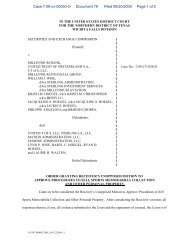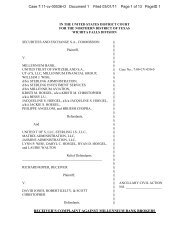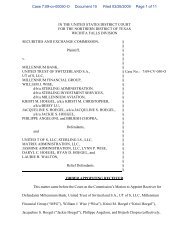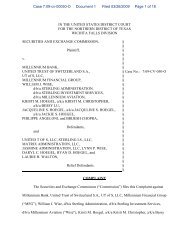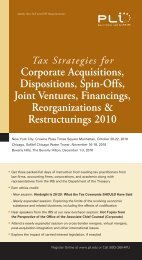View the full text of this document - Martindale.com
View the full text of this document - Martindale.com
View the full text of this document - Martindale.com
You also want an ePaper? Increase the reach of your titles
YUMPU automatically turns print PDFs into web optimized ePapers that Google loves.
egulatory trends<br />
Climate for Change —<br />
and Opportunity<br />
By John M. Toth<br />
Global climate change, no<br />
matter what its scientific<br />
acceptance, is a regulatory<br />
and business<br />
reality. The U.S. Supreme Court’s<br />
2007 Massachusetts v. Environmental<br />
Protection Agency ruling that <strong>the</strong> EPA<br />
can regulate mobile source greenhouse<br />
gas emissions under <strong>the</strong> Clean<br />
Air Act illustrates <strong>this</strong> fact. However,<br />
says Gabrielle Sigel, co-chair <strong>of</strong><br />
Jenner & Block’s Climate and Clean<br />
Technology Law Practice, many<br />
major <strong>com</strong>panies are moving ahead<br />
<strong>of</strong> regulatory action to develop<br />
“verifiable, transparent and clearly<br />
articulated strategies for reducing<br />
<strong>the</strong>ir greenhouse gas emissions.”<br />
Such strategies may involve significant<br />
costs and even business<br />
disruption for organizations, but<br />
Robert L. Graham, also co-chair <strong>of</strong><br />
Jenner & Block’s Climate and Clean<br />
Technology Law Practice, believes<br />
<strong>the</strong>y will create substantial opportunities.<br />
“Companies that proactively deal<br />
with global climate change today,” he asserts,<br />
“will be analogous to those that took first<br />
advantage <strong>of</strong> Silicon Valley’s digital revolution<br />
20 years ago.”<br />
A Regulatory Crazy Quilt<br />
The key issue for corporate America in <strong>the</strong><br />
rapidly evolving regulation <strong>of</strong> greenhouse<br />
gases is whe<strong>the</strong>r to support a single federal<br />
standard, or ac<strong>com</strong>modate a wide range <strong>of</strong><br />
state programs that Sigel believes could<br />
produce “a crazy quilt <strong>of</strong> different standards<br />
and requirements.” Although some states<br />
may keep regulation minimal, o<strong>the</strong>rs,<br />
including Illinois and Massachusetts, are<br />
“Companies that proactively deal with<br />
global climate change today will be<br />
analogous to those that took first<br />
advantage <strong>of</strong> Silicon Valley’s digital<br />
revolution 20 years ago.”<br />
considering strict emission controls and<br />
trading systems for emission credits.<br />
California has already mandated that<br />
<strong>com</strong>panies in <strong>the</strong> state lower <strong>the</strong>ir<br />
greenhouse gas emissions to 1990 levels<br />
by 2020.<br />
Given <strong>this</strong> disparity in state regulation,<br />
Sigel says that any <strong>com</strong>pany with multistate<br />
operations should actively advocate for<br />
a consistent federal regulatory approach<br />
that supercedes fragmented state action.<br />
Ultimately, any federal program will likely<br />
require emissions reduction from a baseline<br />
level, as California does now. “The<br />
problem,” Sigel adds, “is that <strong>the</strong>re is no<br />
Tim Teebken/Photodisc Green/Getty Images<br />
clearly articulated protocol or<br />
standard for determining baseline<br />
emissions in such a way that<br />
<strong>com</strong>panies can get credit for<br />
reducing <strong>the</strong>m.” However, she<br />
re<strong>com</strong>mends that ra<strong>the</strong>r than wait<br />
for a single standard to emerge,<br />
<strong>com</strong>panies should prepare for<br />
<strong>com</strong>prehensive federal regulation by<br />
measuring and monitoring CO 2<br />
emissions now, to build a proactive<br />
record that will be verifiable under<br />
any future emissions reduction<br />
rules.<br />
Know Thyself<br />
Businesses should pursue additional<br />
plans for stronger greenhouse<br />
gas regulation, says Graham. He<br />
defines <strong>the</strong> aim <strong>of</strong> <strong>the</strong> planning<br />
process as “simultaneously<br />
transforming your organization<br />
and working to influence events,<br />
to be a driver and not a victim<br />
<strong>of</strong> <strong>the</strong> new regulatory environment.”<br />
A multifaceted approach should begin with<br />
an understanding <strong>of</strong> climate change issues,<br />
an assessment <strong>of</strong> how those issues impact<br />
organizational needs and a pragmatic effort<br />
to influence decision makers as <strong>the</strong>y develop<br />
<strong>the</strong> new regulatory structure. Proactive<br />
examination <strong>of</strong> <strong>the</strong> roles that both suppliers<br />
and customers play is crucial—as Graham<br />
notes. “If you buy products from suppliers<br />
that have a large carbon footprint, at <strong>the</strong><br />
very least you will face cost-push price<br />
pressures as <strong>the</strong>se <strong>com</strong>panies face higher<br />
<strong>com</strong>pliance costs.”<br />
The <strong>com</strong>pliance assessment process is a<br />
business issue, not just a legal one. “Carbon<br />
24 www.martindale.<strong>com</strong>



